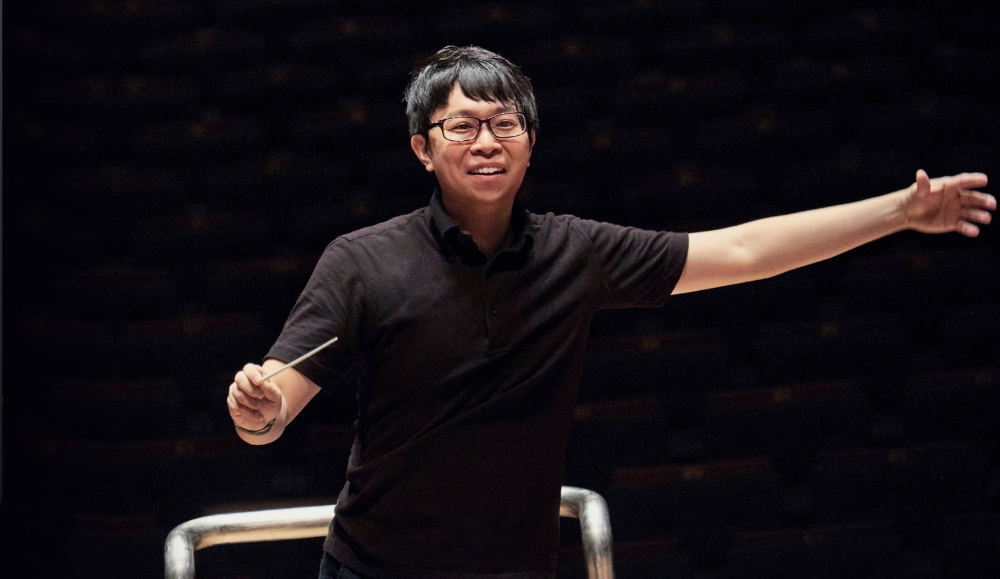While experiencing Seattle Symphony’s Sunday matinee performance (April 14) of Gustav Mahler’s Symphony No. 3, I mused as much on its creator as a conductor as on his composition itself. This was my response to Singaporean conductor Kahchun Wong, whose energetic Mahler-like exertions were as vital a part of the performance as the brilliant sound he elicited from the orchestra.
I am generally put off by conductors who are more flamboyantly animated in their podium antics than necessary, but in this case conductor Wong’s dynamic way with communicating musical ideas fit the piece. Indeed, his gestures with hands, baton, and body were wholly in keeping with Mahler’s own extroverted conducting style. Surely maestro Wong is aware of the celebrated caricature of Mahler himself doing these very things. Many of Wong’s thrusting downbeats, sweeping gyrations, and florid prestidigitations came off as uncanny reproductions of Gustav’s similar conducting mannerisms. Mahler would have been flattered.
But imitating a conducting style is one thing. Getting a compelling, satisfying performance while using these effects is another. In the case of this performance, Wong was most impressive until the very last moments.
On the page, Mahler’s 3rd Symphony (his longest) looks like a giant sprawl of notes, but in fact it is one of his most tightly integrated scores. Motifs and instrumental effects that emerge as embryonic whispers in the massive opening movement return in later sections in more developed form. A successful interpreter knows how to integrate it all through its 90-minute length while not losing sight of each movement’s unique philosophic tint. Mahler saw the progression of these six movements (like the creation story in Genesis) as a march through the “great chain of being”, from minerals upwards through plants, animals, man, angels, and “love” — which the spiritually enigmatic composer substituted for “god.”
A perceptive conductor does not simply roll through the work as a series of musically contrasting sections but finds a way to pull it together as one grand cumulative, emotional crescendo. Kahchun Wong succeeded impressively with an over-arching sense of purpose and direction.
As the thematic march progressed from the funereal to the triumphant, Wong maintained the tension while allowing for episodes of natural-sounding ebb and flow. The recapitulation came off as a bit unprepared and abrupt, but the final bars had the requisite tinge of irony in its brash fanfares, especially in monumental hammerings of timpanist Eric Schweikert, which were crucial to the stirring conclusions to all the movements.
One of the great strengths of this performance was how much Wong reveled in Mahler’s bitingly deliberate vulgarities, especially in the bucolic bird calls in the winds of the third movement. Many conductors try to smooth these passages out, but Wong gave them their full cry, remaining true to Mahler’s penchant for the unsettling grotesque.
This was underlined by oboist Mary Lynch VanderKolk’s amusingly unnerving upwards glissandi and the mocking laughter of Ben Lulich’s clarinet. Balancing them was first trumpet David Gordon whose eerie “Pan motif” iterations in the first movement had a splendid dying fall, while the Posthorn solo in the third movement was nostalgically sweet and satisfyingly in sync with the far distant stage.
Once Wong moved onto the final three movements, which Mahler indicated must be played without interruption, the final half of the performance flowed beautifully. Julie Boulianne’s velvety mezzo-soprano hasn’t quite the saturnine, “earth mother” gravity typically associated with the Zarathustra lied “O mensch.” I was immensely moved by the elegant poise of Boulianne’s phrasing and subtle word pointing. It made the fourth movement a surprisingly comforting transition and helped set up the bright naïveté of the Wunderhorn vision of heaven in part five, marvelously delivered with superb diction by the Northwest Boychoir and the women of the Symphony Chorale.
It is in the execution of the sixth movement Adagio that the mettle of Mahler conductors is truly tested. Maintaining the momentum of this 25-minute-long crescendo takes discipline and grace. Wong began it beautifully, often setting aside his baton to pull the lengthy melody along with sinuous movements of his fingers.
Then, as the movement rose to its commanding climax, things went awry. At its peak, Mahler calls for a single suspended cymbal crash with the proviso that it “might” need to be reinforced with a second player to blend in with the massed orchestral forces. At this performance, not only were there FOUR sets of cymbals arrayed across the stage, and the players themselves were choreographed to march in a ritualistic manner and crash away with over-the-top visual swagger. The resulting clamor was badly out of proportion with the score and the visual bravado came off as a distracting irritation, taking the thunder out of the grand organ-like swell of the glorious final chord.
While this melodramatic miscalculation dampened my enthusiasm at the conclusion, it did not compromise what was overall some of the finest Mahler music making from the Seattle Symphony in recent memory.
Discover more from Post Alley
Subscribe to get the latest posts sent to your email.

I am so glad that Mr. Deacon has started regularly reviewing the SS concerts, as the Times has more or less dropped classical music coverage. Thanks, keep it coming!
As noted here, the cymbal performance (stunt) displayed ignorance of the entire work. I’m quite sure this very young conductor is reading his reviews. Please, don’t do it again.
On the Mahler 3rd final crescendo, I believe the extra cymbals added a wonderful hi light to a fantastic finish and was a crowd pleaser!